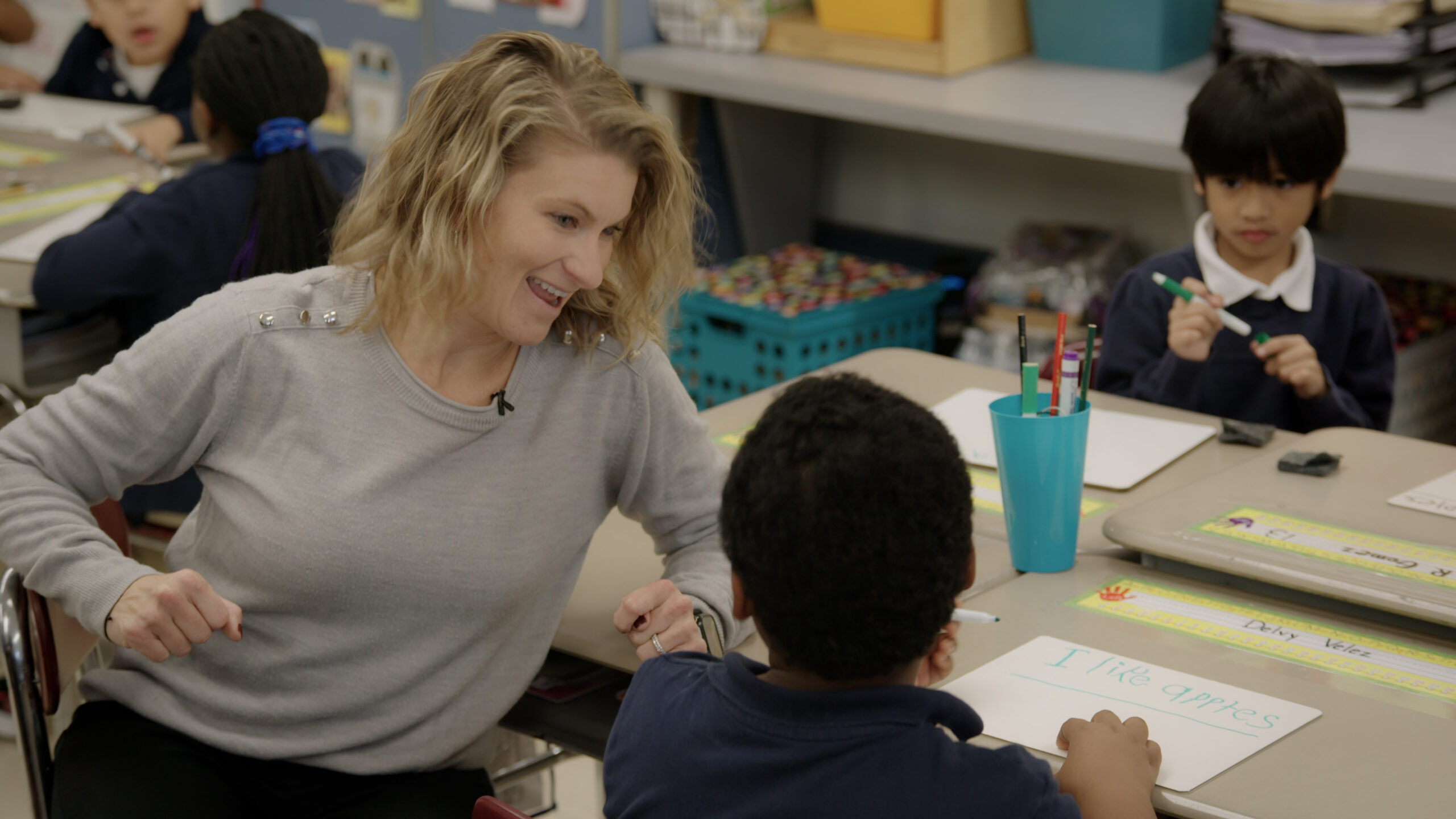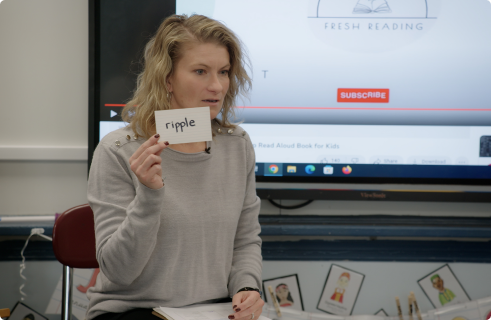Dictation and Word Meaning in an Explicit Phonics Lesson
Overview
In Part 3 of the explicit phonics instructional components, the teacher conducts a daily dictation practice on whiteboards with students to observe which sounds and letters are mastered and which ones may need more review. Next, we see the teacher providing brief, student-friendly definitions for a set of words. The students engage in partner discussions and gestures showcase word meaning. In the final segment, the teacher meets with a targeted small group of students to connect new sound patterns to a controlled text.
Key Take-aways
• Dictation is a daily informal check for student understanding of phoneme/grapheme connection and to apply new phonics skills to writing,
• While working with words that align to our phonics continuum, we also want to be sure students understand the word meaning. This can be a fun and creative practice.
• Decodable or controlled texts allow students to recognize new and previously taught sound patterns in context, building fluency, content knowledge, and comprehension.
Transcript
Dr. Ken Kunz: The teacher skillfully checks for understanding through dictation. Offering an opportunity for informal encoding and identifying concepts mastered. A transition follows where the teacher provides succinct student-friendly definitions, sparking lively interactions such as acting out words. The video concludes with the teacher linking new sound patterns and words to a decodable text and targeted small group work with sound cards.
Teacher: So, what we’re going to do now is we are going to practice some sounds. Okay? We are going to think about the sound that I’m saying. We’re going to write it down and then we’re going to show it. Okay? Can you do that with me?
Student(s): Yeah.
Teacher: Think. Write. Show. You ready? Okay.
Teacher: First sound. /i/. Think. Write. Show. /i/. Just the sound. Good. Come on group one. Excellent. Very good. Hold it up. Show. Good job, David. All right. What letter do we write down?
Student(s): I
Teacher: What sound does I make?
Student(s): /i/
Teacher: Excellent. Okay, erase. Okay. You ready for the next sound?
Student(s): Yes.
Teacher: Okay. The sound is… look at my lips. Watch my lips too, so you can see what I’m saying. /p/. Think. Write. Hold it up. Very good. What letter did we write down?
Student(s): P
Teacher: And what sound does P say?
Student(s): /p/
Teacher: Remember /p/ /p/. Right. Cut that sound. Good. Erase. /sh/. Write it down. Next one. Next one. Ready? I want you to write. /st/. Good. Good. All right. Erase.
Teacher: Okay, now we’re going to do a little bit harder one. Are you ready? Yeah.
Student(s): I love hard ones.
Teacher: I know I’m going to challenge you. Are you ready? Okay. The word is she. Write it down. She. Good. You did it. You did it. Okay. Erase. I’ll give you another one. I’ll give you another hard one. Ready?
Student(s): Give us a hard one.
Teacher: All right. Are we ready? Okay. The word is sit. Sit. Good, good, good. Let me think. You’re missing a letter. Sounds it out on your arms. Sounds it out on your arms. Do it. It doesn’t go there. It. All right, erase.
Dr. Ken Kunz: Dictation allows students to practice connecting the sound to the letters and words on the page through writing.
Teacher: Who can come up and act out ragged with my piece of paper? Zoe, wanna try it? What can you do to this piece of paper to make it old and ragged? Good. Is she right? Yes. Now take a look at this paper. It’s all ragged. And what other word means the same as ragged? What was the other one? Not ripped. What was the other one? Tatter. Who said it? Jenna, say it louder.
Student(s): Tattered.
Teacher: So both of these mean…
Student(s): the same thing.
Teacher: This looks like this. Oh, old and torn. Good. Excellent job. You can go sit down. Let’s do this—next one. I want you to think about a time when you had to keep a secret. Think about it. This one’s a little different. I want you to think about how you would act out a ripple. All right. Freeze. Come back to me. 5, 4, 3, 2. I want one person or a few people come to come up and show us how you can act out the word ripple. Jenna, can you come on up? How can you act out ripple? How can you act out ripple? Ooh. Is she rip? Is she showing Ripple? Are her hands moving like little waves? Yes. Excellent. You got it. Very good.
Teacher: So we’re going to read a story and we’re going to see if we can find some S sounds in there together. And then we’re going to write a sentence with the S sounds in it. Yep, you’re right. Okay. Are we ready? So here’s our books. Okay. Put your finger on the first word for me. Go ahead.
Student(s): I see the school.
Teacher: Perfect. Very good. Let’s turn to the first page. We’re going to do the same thing. All right. We’re going to put our finger on the first part. We’re going read it together, and then we’re going to talk about to see if we see any words that begin with the letter S or have the S sound. All right. We ready? Just one. Okay. Finger on the first word. Ready. Milan.
Student(s): I see the classrooms.
Teacher: Very good. You stretched it out very well.
Student(s): I see an S here.
Teacher: Yep. All right. So what word do we see with the S sound in it?
Student(s): See. Excellent. You agree? You agree? Okay. Ready Camilla? Let’s turn to the next page.


